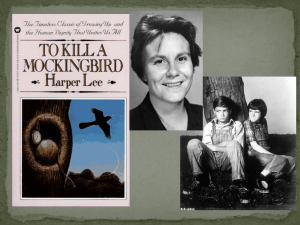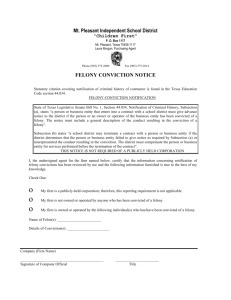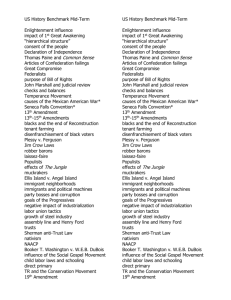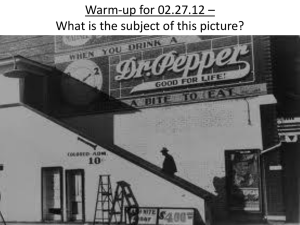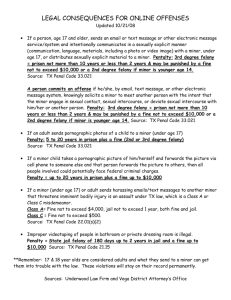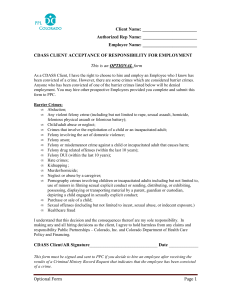Challenges to Felony Disenfranchisement Laws
advertisement
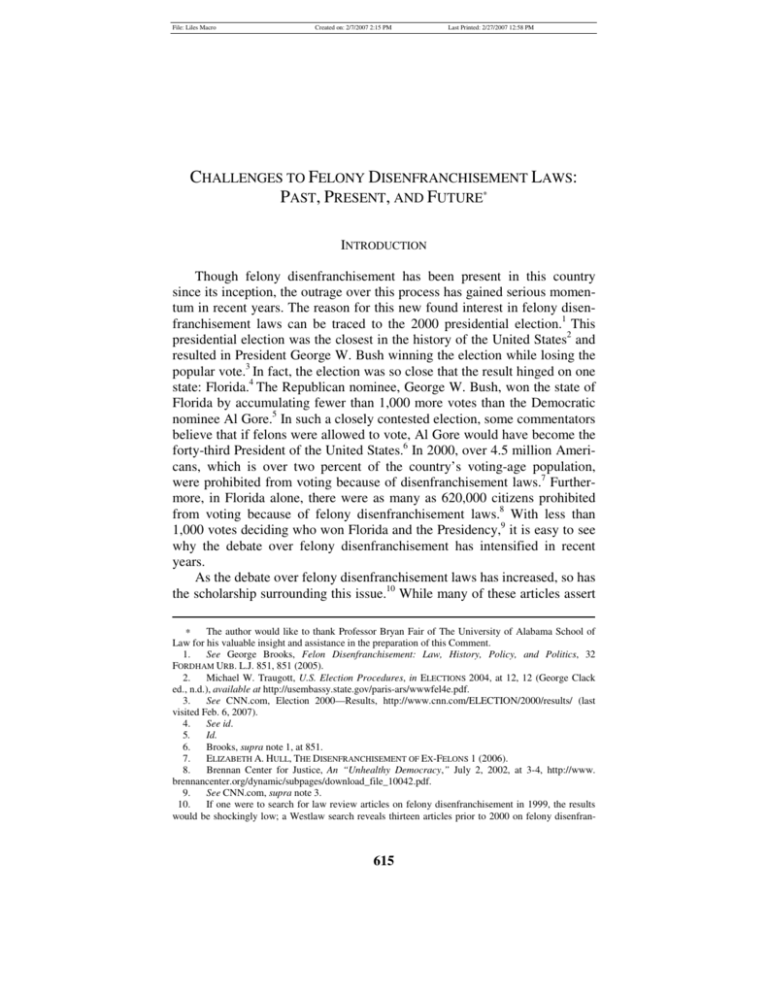
File: Liles Macro Created on: 2/7/2007 2:15 PM Last Printed: 2/27/2007 12:58 PM CHALLENGES TO FELONY DISENFRANCHISEMENT LAWS: PAST, PRESENT, AND FUTURE∗ INTRODUCTION Though felony disenfranchisement has been present in this country since its inception, the outrage over this process has gained serious momentum in recent years. The reason for this new found interest in felony disenfranchisement laws can be traced to the 2000 presidential election.1 This presidential election was the closest in the history of the United States2 and resulted in President George W. Bush winning the election while losing the popular vote.3 In fact, the election was so close that the result hinged on one state: Florida.4 The Republican nominee, George W. Bush, won the state of Florida by accumulating fewer than 1,000 more votes than the Democratic nominee Al Gore.5 In such a closely contested election, some commentators believe that if felons were allowed to vote, Al Gore would have become the forty-third President of the United States.6 In 2000, over 4.5 million Americans, which is over two percent of the country’s voting-age population, were prohibited from voting because of disenfranchisement laws.7 Furthermore, in Florida alone, there were as many as 620,000 citizens prohibited from voting because of felony disenfranchisement laws.8 With less than 1,000 votes deciding who won Florida and the Presidency,9 it is easy to see why the debate over felony disenfranchisement has intensified in recent years. As the debate over felony disenfranchisement laws has increased, so has the scholarship surrounding this issue.10 While many of these articles assert ∗ The author would like to thank Professor Bryan Fair of The University of Alabama School of Law for his valuable insight and assistance in the preparation of this Comment. 1. See George Brooks, Felon Disenfranchisement: Law, History, Policy, and Politics, 32 FORDHAM URB. L.J. 851, 851 (2005). 2. Michael W. Traugott, U.S. Election Procedures, in ELECTIONS 2004, at 12, 12 (George Clack ed., n.d.), available at http://usembassy.state.gov/paris-ars/wwwfel4e.pdf. 3. See CNN.com, Election 2000—Results, http://www.cnn.com/ELECTION/2000/results/ (last visited Feb. 6, 2007). 4. See id. 5. Id. 6. Brooks, supra note 1, at 851. 7. ELIZABETH A. HULL, THE DISENFRANCHISEMENT OF EX-FELONS 1 (2006). 8. Brennan Center for Justice, An “Unhealthy Democracy,” July 2, 2002, at 3-4, http://www. brennancenter.org/dynamic/subpages/download_file_10042.pdf. 9. See CNN.com, supra note 3. 10. If one were to search for law review articles on felony disenfranchisement in 1999, the results would be shockingly low; a Westlaw search reveals thirteen articles prior to 2000 on felony disenfran- 615 File: Liles Macro 616 Created on: 2/7/2007 2:15 PM Alabama Law Review Last Printed: 2/27/2007 12:58 PM [Vol. 58:3:615 that felony disenfranchisement laws are patently unconstitutional,11 this Comment, however, argues that there are only a few narrow ways to challenge the constitutionality of these laws in light of the relevant jurisprudence. Because felony disenfranchisement laws are in and of themselves constitutional, courts are often the improper forum to seek their abolishment. Rather, individuals desiring to eliminate the disenfranchisement of felons should look to Congress and state legislatures as the more appropriate venues. Part I of this Comment discusses the origins of felony disenfranchisement laws. Part II traces the history of equal protection challenges to felony disenfranchisement laws, and Part III discusses what the future holds for these suits. Next, Part IV of this Comment examines the history of challenges to felony disenfranchisement based on the Voting Rights Act and, in Part V, explains what the future holds for these challenges. I. THE HISTORY OF FELONY DISENFRANCHISEMENT Though a great majority of Americans are currently opposed to felony disenfranchisement laws,12 felony disenfranchisement is far from a new idea as “[d]isenfranchisement in the U.S. is a heritage from ancient Greek and Roman traditions carried into Europe.”13 In the Roman Empire and Greece, criminals were prohibited from appearing in court, making speeches, attending assemblies, serving in the army, and voting.14 Such penalties, known as “civil death,” spread throughout Europe after the fall of Rome.15 Across Europe, civil death took on many different forms. In Germany, for example, the practice of “outlawry” was introduced where “an outlaw was a ‘bando’ or wolf, for if he did not flee to another country he was forced to dwell in the forest like a wild beast.”16 In England, the commonlaw tradition known as “attainder” arose.17 Under this process, “[o]nce conchisement (using a search string of “ti(disfranch! disenfranch!) & felon! & da(bef 2000)” in the “Journals and Law Reviews” database). However, a similar Westlaw search reveals there have been fifty-nine articles on felony disenfranchisement since 2000 (using a search string of “ti(disfranch! disenfranch!) & felon! & da(aft 1999)” in the “Journals and Law Reviews” database). 11. See, e.g., Jason Morgan-Foster, Transnational Judicial Discourse and Felon Disenfranchisement: Re-Examining Richardson v. Ramirez, 13 TULSA J. COMP. & INT’L L. 279 (2006); Susan E. Marquardt, Comment, Deprivation of a Felon’s Right to Vote: Constitutional Concerns, Policy Issues and Suggested Reform for Felony Disenfranchisement Law, 82 U. DET. MERCY L. REV. 279 (2005); Katherine Shaw, Comment, Invoking the Penalty: How Florida’s Felon Disenfranchisement Law Violates the Constitutional Requirement of Population Equality in Congressional Representation, and What to Do About It, 100 NW. U. L. REV. 1439 (2006). 12. See Brian Pinaire, Milton Heumann & Laura Bilotta, Barred from the Vote: Public Attitudes Toward the Disenfranchisement of Felons, 30 FORDHAM URB. L.J. 1519, 1540 (2003) (finding that 81.7% of those surveyed felt the right to vote should be restored to convicted felons at some point). 13. JAMIE FELLNER & MARC MAUER, LOSING THE VOTE: THE IMPACT OF FELONY DISENFRANCHISEMENT LAWS IN THE UNITED STATES 2 (1998). 14. HULL, supra note 7, at 16; Note, The Disenfranchisement of Ex-Felons: Citizenship, Criminality, and “The Purity of the Ballot Box,” 102 HARV. L. REV. 1300, 1301 (1989). 15. HULL, supra note 7, at 16. 16. Id. 17. Id. File: Liles Macro 2007] Created on: 2/7/2007 2:15 PM Last Printed: 2/27/2007 12:58 PM Challenges to Felony Disenfranchisement Laws 617 victed of a heinous crime, an English citizen was pronounced ‘attainted’ and was subject to three penalties: forfeiture, so-called ‘corruption of the blood’ (which prohibited the guilty party from retaining, inheriting, or passing an estate to his heirs), and loss of civil rights.”18 Countries instituted such traditions because “the stigma of the loss of civil rights in the small communities of those times increased the humiliation and isolation suffered by the offender and his family and served as a warning to the rest of the community, all of whom probably knew the offender.”19 When the English colonists came to America, they brought with them their common-law traditions including “civil death.”20 However, as time passed, many of the elements of “civil death” were removed from the common-law tradition.21 Civil prohibitions on such things as entering into contracts and inheriting property were abolished.22 Yet, one aspect of “civil death” remained very much intact in the colonies: felony disenfranchisement.23 Although felony disenfranchisement was present from the time that the first colonists arrived in America, it was not until after the American Revolution that felony disenfranchisement laws were first codified as statutes.24 Virginia became the first state to pass a law prohibiting ex-felons from voting,25 but many more soon followed so that “by the eve of the Civil War some two dozen states had statutes barring felons from voting or had felon disenfranchisement provisions in their state constitutions.”26 Thus, at the time of the Civil War, over seventy percent of the states already had felony disenfranchisement provisions in place.27 By 1869, twenty-nine states had instituted felony disenfranchisement laws, and the number has only increased since then.28 Today, forty-eight states and the District of Columbia disenfranchise felons who are presently incarcerated.29 Thirty-five states prohibit felons from voting while on parole, and thirty states bar voting while on probation.30 Twelve states disenfranchise all or some catego18. Id. 19. Angela Behrens, Note, Voting—Not Quite a Fundamental Right? A Look at Legal and Legislative Challenges to Felon Disfranchisement Laws, 89 MINN. L. REV. 231, 236 (2004) (quoting Howard Itzkowitz & Lauren Oldak, Note, Restoring the Ex-Offender’s Right to Vote: Background and Developments, 11 AM. CRIM. L. REV. 721, 721-24 (1973)) (internal quotation marks omitted). 20. See HULL, supra note 7, at 17. 21. See id. 22. Id. 23. Id. 24. See Brooks, supra note 1, at 853. 25. HULL, supra note 7, at 17. 26. Christopher Uggen & Jeff Manza, Democratic Contraction? Political Consequences of Felon Disenfranchisement in the United States, 67 AM. SOC. REV. 777, 781 (2002). 27. See Roger Clegg, Perps and Politics: Why Felons Can’t Vote, NAT’L REV. ONLINE, Oct. 18, 2004, http://www.nationalreview.com/clegg/clegg200410180844.asp. 28. HULL, supra note 7, at 17. 29. THE SENTENCING PROJECT, FELONY DISENFRANCHISEMENT LAWS IN THE UNITED STATES 1 (2006), available at http://www.sentencingproject.org/pdfs/1046.pdf. Only Vermont and Maine allow inmates to vote. Id. 30. Id. Thirty-five states prohibit felons from voting while on parole: Alabama, Alaska, Arizona, Arkansas, California, Colorado, Connecticut, Delaware, Florida, Georgia, Idaho, Iowa, Kansas, Kentucky, Louisiana, Maryland, Minnesota, Mississippi, Missouri, Nebraska, Nevada, New Jersey, New File: Liles Macro 618 Created on: 2/7/2007 2:15 PM Alabama Law Review Last Printed: 2/27/2007 12:58 PM [Vol. 58:3:615 ries of felons for life, with two of those states disenfranchising felons for life upon a second felony conviction.31 II. THE HISTORY OF EQUAL PROTECTION CHALLENGES TO FELONY DISENFRANCHISEMENT LAWS The first avenue by which felons have challenged felony disenfranchisement laws is by alleging that such laws violate the Equal Protection Clause of the Fourteenth Amendment.32 The Equal Protection Clause provides that “[n]o State shall . . . deny to any person within its jurisdiction the equal protection of the laws.”33 Plaintiffs thus allege that disenfranchisement laws do not provide them the “equal protection of the laws.”34 However, as with “[a]ll equal protection cases” the question is whether the “government’s classification [is] justified by a sufficient purpose.”35 A. Facial Challenges Under the Equal Protection Clause When examining equal protection challenges to felony disenfranchisement laws, one must begin with Richardson v. Ramirez,36 where the United States Supreme Court first considered the constitutionality of such laws. In Richardson, the Court held that the disenfranchisement of convicted felons who had completed their sentences and paroles did not deny them equal protection of the laws.37 In this case, three individuals in California who had been convicted of felonies attempted to register to vote but were denied.38 At the time of the case, article II, section 1, of the California constitution stated that “no person convicted of any infamous crime, no person hereafter convicted of the embezzlement or misappropriation of public money . . . shall ever exercise the privileges of an elector in this State.”39 The convicted felons argued that such a law violated the Equal Protection Clause of the Fourteenth Amendment.40 Mexico, New York, North Carolina, Oklahoma, South Carolina, South Dakota, Tennessee, Texas, Virginia, Washington, West Virginia, Wisconsin, and Wyoming. Id. at 3. The thirty states consist of all the previous states except California, Colorado, Connecticut, New York, and South Dakota. Id. 31. Id. at 1. Twelve states disenfranchise at least some felons for life: Alabama, Arizona, Delaware, Florida, Kentucky, Maryland, Mississippi, Nebraska, Nevada, Tennessee, Virginia, and Wyoming. Id. at 3. The two states that disenfranchise felons upon a second felony conviction are Arizona and Maryland. Id. at 3. 32. See, e.g., Richardson v. Ramirez, 418 U.S. 24, 26 (1974); Johnson v. Bush, 405 F.3d 1214, 1216 (11th Cir. 2005), cert. denied, 126 S. Ct. 650 (2005); Owens v. Barnes, 711 F.2d 25, 25-26 (3d Cir. 1983). 33. U.S. CONST. amend. XIV, § 1. 34. Id. 35. ERWIN CHEMERINSKY, CONSTITUTIONAL LAW: PRINCIPLES AND POLICIES § 9.1.2, at 669 (3d ed. 2006). 36. 418 U.S. 24. 37. Id. at 56. 38. Id. at 26. 39. Id. at 27-28. 40. Id. at 26-27. File: Liles Macro 2007] Created on: 2/7/2007 2:15 PM Last Printed: 2/27/2007 12:58 PM Challenges to Felony Disenfranchisement Laws 619 The California Supreme Court agreed with the plaintiffs and held the law to be unconstitutional.41 In finding for the felons, the California Supreme Court held that the State’s denial of the franchise to the class of exfelons could no longer withstand strict scrutiny under the Equal Protection Clause.42 Relying on the United States Supreme Court’s recent voting-rights cases, the California Supreme Court determined that the disenfranchisement must be accompanied by a compelling state interest.43 However, the United States Supreme Court reversed the California Supreme Court44 and held that the disenfranchisement of felons was different from other voting rights cases because Section 2 of the Fourteenth Amendment explicitly allows for the disenfranchisement of felons.45 Section 2 makes an exception for the denial of voting rights for “participation in rebellion, or other crime.” 46 Because the Fourteenth Amendment is to be read holistically, the United States Supreme Court found that “those who framed and adopted the Fourteenth Amendment could not have intended to prohibit outright in § 1 of that Amendment that which was expressly exempted from the lesser sanction of reduced representation imposed by § 2 of the Amendment.”47 B. Application and Intent Challenges Under the Equal Protection Clause Following the ruling in Richardson, many scholars believed that its holding would forever ensure the constitutionality of felony disenfranchisement laws.48 However, numerous courts have subsequently found ways around Richardson and have recognized different circumstances that would lead to the invalidation of a felony disenfranchisement law. For example, in Thiess v. State Administrative Board of Election Laws,49 the United States District Court of Maryland found one such way to invalidate a felony disenfranchisement law. In this case, which was decided only months after Richardson, the plaintiffs argued that Maryland’s felony disenfranchisement law violated the Equal Protection Clause because the law was unequally enforced.50 Though the court ultimately found for the State because of a lack of evidence of unequal enforcement, it stated that the decision in Richard- 41. (1974). 42. 43. 44. 45. 46. 47. 48. (1981). 49. 50. Ramirez v. Brown, 507 P.2d 1345, 1357 (Cal. 1973), rev’d, Richardson v. Ramirez, 418 U.S. 24 Id. at 1350, 1357. Id. at 1350-51. Richardson, 418 U.S. at 56. Id. at 54. Id. at 42 (quoting U.S. CONST. amend. XIV, § 2) (emphasis omitted). Id. at 43. See Allen v. Ellisor, 664 F.2d 391, 395-96 (4th Cir. 1981), vacated as moot, 454 U.S. 807 387 F. Supp. 1038 (D. Md. 1974). Id. at 1043. File: Liles Macro 620 Created on: 2/7/2007 2:15 PM Alabama Law Review Last Printed: 2/27/2007 12:58 PM [Vol. 58:3:615 son left open the possibility that unequal enforcement may violate the Equal Protection Clause of the Fourteenth Amendment.51 Another possible way in which a felony disenfranchisement law can violate the Equal Protection Clause is if intentional racial discrimination exists. In Richardson, there were allegations of intentional racial discrimination, but because the California Supreme Court had not made a finding on that issue, the United States Supreme Court likewise refused to rule on the allegations of intentional discrimination.52 However, the language of Richardson did allow lower courts to infer that intentional racial discrimination can cause an otherwise constitutional law to be unconstitutional.53 The Fourth Circuit Court of Appeals addressed this very issue in Allen v. Ellisor.54 In Allen, the district court found South Carolina’s felony disenfranchisement law to be unconstitutional because of inconsistencies in the statute’s disqualifying offenses and therefore did not address the plaintiff’s allegations of intentional discrimination.55 The Fourth Circuit reversed the district court’s ruling on the disqualifying offenses and remanded the case to consider the plaintiff’s claims of intentional discrimination.56 The Fourth Circuit found that Richardson v. Ramirez did not preclude a court from finding a disenfranchisement law to be unconstitutional when accompanied by intentional racial discrimination.57 Whereas Allen v. Ellisor dealt with the intent surrounding the enactment of South Carolina’s felony disenfranchisement law,58 other courts have found felony disenfranchisement laws to be unconstitutional when such laws are selectively enforced.59 In Williams v. Taylor,60 the Fifth Circuit Court of Appeals examined a claim of selective enforcement. In this case, the plaintiff was a registered voter in Mississippi who was convicted of grand larceny, which was a crime that led to a lifetime revocation of voting rights in the state.61 When the plaintiff got out of jail, however, he continued 51. Id. 52. Richardson, 418 U.S. at 56. The petitioners challenged the disenfranchisement law on two grounds. “First, it was contended that California’s denial of the franchise to the class of ex-felons could no longer withstand scrutiny under the Equal Protection Clause of the Fourteenth Amendment.” Id. at 33. “Second, respondents contended that application of the challenged California constitutional and statutory provisions by election officials of the State’s 58 counties was so lacking in uniformity as to deny them due process and ‘geographical . . . equal protection.’” Id. Because the Supreme Court of California invalidated the law based on the first challenge, the Court did not address the second challenge. Id. at 33-34. 53. Id. at 56. Though the Supreme Court of the United States did not rule on the second challenge, the Court did remand the case to the California court and stated “that it should have an opportunity to consider the claim before we address ourselves to it.” Id. This remand gave some credence to the view that unequal enforcement or intentional discrimination of a felony disenfranchisement law might violate the Equal Protection Clause of the Fourteenth Amendment. 54. 664 F.2d 391 (4th Cir. 1981), vacated as moot, 454 U.S. 807 (1981). 55. Id. at 393, 399. 56. Id. at 399. 57. Id. 58. Id. 59. See Williams v. Taylor, 677 F.2d 510 (5th Cir. 1982). 60. Id. 61. Id. at 512-13. File: Liles Macro 2007] Created on: 2/7/2007 2:15 PM Last Printed: 2/27/2007 12:58 PM Challenges to Felony Disenfranchisement Laws 621 to vote for twelve years until he was removed from the state’s voter registration lists.62 The plaintiff argued that the county was unequally enforcing the disenfranchisement law because it had not followed the statutory procedures that called for automatic disenfranchisement upon conviction of grand larceny.63 The district court held that the Mississippi statute was constitutional and rejected the plaintiff’s claim of selective enforcement.64 The Fifth Circuit reversed the lower court and found that selective enforcement can indeed lead to the invalidation of an otherwise constitutional disenfranchisement law.65 The logic followed by both the Fourth Circuit in Allen v. Ellisor and the Fifth Circuit in Williams v. Taylor was later validated by the Supreme Court’s decision in Hunter v. Underwood.66 In Hunter, the appellees challenged article VIII, section 182 of the Alabama Constitution of 1901, which barred individuals who had committed crimes of “moral turpitude” from voting.67 The appellees argued that the use of an ambiguous criteria such as “moral turpitude” was intentionally adopted to disenfranchise AfricanAmericans on account of race.68 The Supreme Court of the United States held that normal equal protection analysis applied, and since the law was facially neutral, the proper test was whether or not there was a discriminatory impact as well as discriminatory intent.69 The Court found both that the purpose of this section of the Alabama constitution was indeed to discriminate against African-Americans and that discrimination had occurred.70 Thus, the Court held that the law was unconstitutional as a violation of the Equal Protection Clause of the Fourteenth Amendment.71 Though Hunter v. Underwood was the last time that the Supreme Court expressly dealt with equal protection challenges to felony disenfranchisement laws, lower courts are still grappling with the holdings of both Richardson and Hunter. One significant post-Hunter case is McLaughlin v. City of Canton.72 In this case, the plaintiff was convicted of a misdemeanor for bouncing a bad check and as a result was disqualified from voting.73 The plaintiff challenged Mississippi’s disenfranchisement law because rather than just applying to felonies, the law also applied to specific, enumerated misdemeanors.74 The district court subjected the law to a strict scrutiny rather than rational basis scrutiny, thus forcing the state to show a compel62. 63. 64. 65. 66. 67. 68. 69. 70. 71. 72. 73. 74. See id. Id. at 512. Id. at 512, 515. Id. at 518. 471 U.S. 222 (1985). Id. at 223-24. Id. Id. at 227. Id. at 232. Id. at 233. 947 F. Supp. 954 (S.D. Miss. 1995). Id. at 958-59. Id. at 961. File: Liles Macro 622 Created on: 2/7/2007 2:15 PM Alabama Law Review Last Printed: 2/27/2007 12:58 PM [Vol. 58:3:615 ling reason for denying the vote.75 The court found that the heightened level of scrutiny was appropriate because Richardson v. Ramirez applied only to felony disenfranchisement laws.76 Thus, non-felony disenfranchisement laws should be subject to strict scrutiny—as is the case with other limitations on voting rights.77 The court then held that there was no compelling reason to deny the vote for certain misdemeanors but not others.78 Though Hunter v. Underwood seemed to clearly stand for the proposition that felony disenfranchisement laws enacted with discriminatory intent would be found unconstitutional, the Fifth Circuit believed that the holding was not an absolute invalidation of all disenfranchisement laws enacted with a discriminatory purpose.79 In Cotton v. Fordice,80 the plaintiff was convicted of armed robbery and stripped of his voting rights under Mississippi’s felony disenfranchisement law.81 He argued that Mississippi’s law was unconstitutional because it was enacted to discriminate against AfricanAmericans, which fell squarely under the holding of Hunter v. Underwood.82 The Fifth Circuit disagreed and found the law to be constitutional.83 Although the original statute was enacted to discriminate against AfricanAmericans and included only crimes thought to be primarily committed by African-Americans,84 subsequent amendments that broadened the list of crimes removed the discriminatory taint associated with the original version.85 Thus, the Fifth Circuit found that the original discriminatory intent of the statute was no longer present, and thus the current statute was not unconstitutional.86 It is clear from the above discussion that there have been many challenges to felony disenfranchisement laws in the United States. Although the Supreme Court has only ruled twice on such challenges, its holdings, as well as the decisions of lower federal courts, have established guidelines regarding what must be present to successfully challenge a felony disenfranchisement law under the Equal Protection Clause. Using the aforementioned cases, the next Part of this Comment will set forth these parameters and discuss the future of equal protection challenges to felony disenfranchisement laws. 75. 76. 77. 78. 79. 80. 81. 82. 83. 84. 85. 86. Id. at 975-76. Id. at 974-75. Id. Id. See Cotton v. Fordice, 157 F.3d 388 (5th Cir. 1998). Id. at 389. Id. Id. at 390. Id. at 391. Id. Id. at 392. See id. File: Liles Macro 2007] Created on: 2/7/2007 2:15 PM Last Printed: 2/27/2007 12:58 PM Challenges to Felony Disenfranchisement Laws 623 III. THE FUTURE OF EQUAL PROTECTION CHALLENGES TO FELONY DISENFRANCHISEMENT LAWS When the Supreme Court handed down its opinion in Richardson v. Ramirez, many thought it would be impossible to successfully challenge the constitutionality of a felony disenfranchisement law under the Equal Protection Clause. However, in the years following Richardson v. Ramirez, the Supreme Court and other federal courts have recognized ways that one can successfully challenge a felony disenfranchisement law on equal protection grounds. The first way to successfully challenge a felony disenfranchisement law is to show a pattern of unequal or selective enforcement. This exception to the general constitutionality of felony disenfranchisement stems from what the Supreme Court did not do in Richardson. In that case, the plaintiffs had two claims, the one discussed above87 and a claim that the enforcement of the law was lacking uniformity.88 Because the California Supreme Court had found the law to facially violate the Equal Protection Clause of the Fourteenth Amendment, it did not discuss the second claim.89 Thus, upon appeal, the United States Supreme Court did not address the lack of uniformity in enforcement.90 However, the Court did say that “we believe that [the California court] should have an opportunity to consider the claim before we address ourselves to it.”91 It is this very principle that the judges in Williams v. Taylor would point to in order to clearly establish that selective enforcement of an otherwise constitutional disenfranchisement law makes the law unconstitutional.92 The second manner in which a successful challenge to a felony disenfranchisement law can be mounted is by showing that the law was enacted to intentionally discriminate. Though Richardson did not address any such claim, the lower federal courts quickly decided that the Supreme Court could not have meant to uphold the constitutionality of laws that intentionally discriminated against minorities. In Allen v. Ellisor,93 the Fourth Circuit Court of Appeals held that a facially valid disenfranchisement law can be successfully challenged on grounds that the terms of the statute are racially tainted.94 Following Allen, the Supreme Court sought to clarify its position regarding felony disenfranchisement. In Hunter v. Underwood, the Supreme Court clearly stated that “we are confident that § 2 [of the Fourteenth Amendment] was not designed to permit the purposeful racial discrimina87. See supra Part II.A. The first claim was that the law facially violated the Equal Protection Clause of the Fourteenth Amendment regardless of intent. Richardson v. Ramirez, 418 U.S. 24, 33 (1974). 88. Richardson, 418 U.S. at 34. 89. Id. at 33-34. 90. Id. at 56. 91. Id. 92. See Williams v. Taylor, 677 F.2d 510, 517 (5th Cir. 1982). 93. 664 F.2d 391 (4th Cir. 1981), vacated as moot, 454 U.S. 807 (1981). 94. Id. at 399. File: Liles Macro 624 Created on: 2/7/2007 2:15 PM Alabama Law Review Last Printed: 2/27/2007 12:58 PM [Vol. 58:3:615 tion attending the enactment and operation [of a disenfranchisement law] which otherwise violates § 1 of the Fourteenth Amendment. Nothing in our opinion in Richardson v. Ramirez . . . suggests the contrary.”95 The holding of Hunter v. Underwood seemed to indicate that any disenfranchisement law enacted with a discriminatory purpose would be unconstitutional. However, the Fifth Circuit Court of Appeals found some wiggle room and determined that, even if a law were enacted with discriminatory intent, the law can still be constitutional as long as actions have been taken since the enactment that show such intent no longer exists.96 Though the holding in Cotton v. Fordice is unique, in denying certiorari, the Supreme Court of the United States has given some credence to the opinion of the Fifth Circuit.97 Thus, a facial challenge to a felony disenfranchisement law on equal protection grounds is unlikely to be successful. However, if there has been selective enforcement of the law or that the law was enacted with a discriminatory purpose, one is likely to successfully challenge such a law on equal protection grounds. Because the jurisprudence on equal protection challenges to felony disenfranchisement laws is fairly well settled, those in opposition to such laws have begun to challenge them under the Voting Rights Act. IV. THE HISTORY OF VOTING RIGHTS ACT CHALLENGES TO FELONY DISENFRANCHISEMENT LAWS As a result of the Supreme Court holdings in Richardson v. Ramirez and Hunter v. Underwood, it was apparent that very few felony disenfranchisement laws would be deemed unconstitutional as a violation of the Equal Protection Clause. Thus, those who opposed these laws looked for another way to have them declared unconstitutional, eventually challenging felony disenfranchisement laws on the ground that the laws violate Section 2 of the Voting Rights Act.98 Although challenges under the Voting Rights Act began twenty years ago, the law in this area is far from settled. Different circuits have very different views on such challenges. Because the Supreme Court has consistently denied certiorari for such cases, the likely success of one’s challenge depends greatly on what court the challenge is instituted in. Below is a discussion of five of the cases where the circuits have expressed 95. 96. 97. 98. 471 U.S. 222, 233 (1985). See Cotton v. Fordice, 157 F.3d 388, 392 (5th Cir. 1998). Id. at 391. HULL, supra note 7, at 104-05. Section 2 of the Voting Rights Act states: No voting qualification or prerequisite to voting or standard, practice, or procedure shall be imposed or applied by any State or political subdivision in a manner which results in a denial or abridgement of the right of any citizen of the United States to vote on account of race or color. 42 U.S.C. § 1973(a) (2000). Thus, these challenges concentrate on the fact that a far greater percentage of African-Americans are disenfranchised as a result of felony disenfranchisement laws than are whites. File: Liles Macro 2007] Created on: 2/7/2007 2:15 PM Last Printed: 2/27/2007 12:58 PM Challenges to Felony Disenfranchisement Laws 625 their views on Voting Rights Acts challenges to felony disenfranchisement laws. One of the first cases to challenge felony disenfranchisement laws under the Voting Rights Act was Wesley v. Collins.99 In Wesley, the plaintiff brought a lawsuit challenging Tennessee’s felony disenfranchisement law.100 Like most plaintiffs before him, the plaintiff challenged the law under the Equal Protection Clause of the Fourteenth Amendment.101 However, in a new approach, he also challenged the law on the grounds that the law violated Section 2 of the Voting Rights Act by denying the vote on the account of race.102 Even though the Sixth Circuit Court of Appeals found the law constitutional, this case is significant because it clearly recognized the validity of the Voting Rights Act challenge and ruled for the defendant not because such a claim could not proceed legally but because the facts did not support the claim.103 Though the Sixth Circuit’s holding in Wesley left open the possibility for challenges to felony disenfranchisement laws under the Voting Rights Act, it was almost ten years until another case was heard at the circuit level.104 In Baker v. Pataki,105 plaintiffs challenged New York’s felony disenfranchisement statute on the grounds that it violated the Equal Protection Clause of the Fourteen Amendment as well as Section 2 of the Voting Rights Act.106 The lower court dismissed the complaint, holding that the equal protection claim was insufficient in light of the Supreme Court’s holding in Richardson v. Ramirez and that the Voting Rights Act did not apply to felony disenfranchisement laws.107 The Second Circuit reversed the decision of the lower court with regard to the equal protection claim to allow the plaintiffs to attempt to prove intentional racial discrimination.108 Originally, the Second Circuit ruled that the plaintiffs should be given an opportunity to submit evidence that the disenfranchisement law had a disproportionate racial impact in violation of the Voting Rights Act.109 However, the Second Circuit then decided to sit en banc with regards to the Voting Rights Act challenge, and the ten judges were divided five to five regarding the validity of a Voting Rights Act challenge to a felony disenfranchisement law.110 Because the lower court had ruled that the Voting Rights Act did not apply to 99. 100. 101. 102. 103. 104. 105. 106. 107. 108. 109. 110. 791 F.2d 1255 (6th Cir. 1986). Id. at 1257. Id. Id. Id. at 1259. See Baker v. Pataki, 85 F.3d 919 (2d Cir. 1996). Id. Id. at 919. Id. Id. at 921. Id. Id. File: Liles Macro 626 Created on: 2/7/2007 2:15 PM Alabama Law Review Last Printed: 2/27/2007 12:58 PM [Vol. 58:3:615 felony disenfranchisement laws, the five to five split led to the affirmation of the lower court decision.111 With an even split on the validity of Voting Rights Acts challenges in the Second Circuit, it is not surprising that another challenge to New York’s felony disenfranchisement law made its way to the Second Circuit. The Second Circuit heard Muntaqim v. Coombe in 2004.112 In Muntaqim, a plaintiff once again argued that New York’s law resulted in the denial of the right to vote on account of race in violation of Section 2 of the Voting Rights Act.113 The district court granted the defendant’s motion to dismiss because of the holding in Baker v. Pataki.114 The Second Circuit did not change its position in this case and once again concluded that the Voting Rights Act did not apply to felony disenfranchisement laws because Congress had not explicitly stated its intention for the Act to apply to such laws.115 The court held that without a clear statement from Congress, it would not interpret the Voting Rights Act to prohibit felony disenfranchisement laws.116 It refused to infringe upon the states’ well-established discretion to deny the vote to those convicted of felonies and thereby disturb the balance between the states and the federal government.117 In contrast to the Second Circuit, the Ninth Circuit Court of Appeals has found that one can challenge a felony disenfranchisement law under Section 2 of the Voting Rights Act.118 In Farrakhan v. Washington,119 the Ninth Circuit overturned a lower court decision dismissing claims by minority plaintiffs challenging Washington’s felony disenfranchisement law.120 The plaintiffs introduced evidence showing that, as a result of discrimination in the criminal justice system, voters of color were disproportionately denied the right to vote.121 Thus, the law violated Section 2.122 The lower court held that discrimination in the criminal justice system was not relevant to whether the felony disenfranchisement provision itself was discriminatory.123 In reversing the district court, the Ninth Circuit held that racial bias in the criminal justice system is a relevant social and historical factor that courts may consider in determining whether disenfranchisement laws discriminate on account of race.124 Although the case was only remanded for 111. Id. 112. See Muntaqim v. Coombe, 366 F.3d 102 (2d Cir. 2004), vacated for lack of standing, 449 F.3d 371 (2d Cir. 2006). 113. Id. at 105. 114. See id. at 106, 111. 115. Id. at 130. 116. Id. 117. Id. 118. See Farrakhan v. Washington, 338 F.3d 1009, 1011-12 (9th Cir. 2003). 119. Id. 120. Id. at 1011. 121. Id. 122. Id. at 1012. 123. Id. at 1011. 124. Id. at 1011-12. File: Liles Macro 2007] Created on: 2/7/2007 2:15 PM Last Printed: 2/27/2007 12:58 PM Challenges to Felony Disenfranchisement Laws 627 retrial,125 the Ninth Circuit’s holding in Farrakhan established that challenges under Section 2 of the Voting Rights Act are appropriate and can be successful. The most recent case involving a Voting Rights Act challenge to a felony disenfranchisement law is Johnson v. Bush.126 In this case, the plaintiffs, all convicted felons in Florida, instituted a class action lawsuit against the state’s clemency board and Governor Jeb Bush.127 They alleged that the permanent felony disenfranchisement provisions contained in Florida’s constitution and statutes had a significantly disproportionate impact on AfricanAmericans and denied plaintiffs the right to vote on account of race in violation of Section 2 of the Voting Rights Act.128 The district court granted the defendant’s motion for summary judgment, but the Eleventh Circuit reversed and sent the case back to the lower court for trial.129 However, the Eleventh Circuit, sitting en banc, vacated the panel decision and affirmed the summary judgment grant.130 In doing so, it held that the Voting Rights Act’s prohibition against voting qualifications that result in abridgement of the right to vote on account of race did not apply to the felony disenfranchisement provision.131 V. THE FUTURE OF VOTING RIGHTS ACT CHALLENGES TO FELONY DISENFRANCHISEMENT LAWS When looking at the aforementioned cases, the only clear fact is that the circuits disagree on whether or not Voting Rights Act challenges to felony disenfranchisement laws are even possible. Perhaps what is more disturbing than the circuit split is the Supreme Court’s continuing refusal to grant certiorari to any of these cases. Following the decision in Johnson v. Bush, the plaintiffs filed a petition for certiorari which was denied.132 If viewed by itself, it would seem that the Supreme Court is advocating the position that the Voting Rights Act was not meant to apply to felony disenfranchisement laws. However, when looking at the fact that the Supreme Court also refused to grant certiorari in the Farrakhan v. Washington case, one does not know what to make of the Supreme Court’s refusal to hear such challenges.133 Furthermore, the fact that the circuit alignments are quite odd also makes it difficult to determine what is likely to happen. In rare agreement, the more liberal Second Circuit and the more conservative Eleventh Circuit 125. 126. 127. 128. 129. 130. 131. 132. 133. Id. 405 F.3d 1214 (11th Cir. 2005), cert. denied, 126 S. Ct. 650 (2005). Id. at 1216-17. Id. at 1217. Id. Id. at 1235. Id. at 1234. Johnson v. Bush, 126 S. Ct. 650 (2005). Locke v. Farrakhan, 543 U.S. 984 (2004). File: Liles Macro 628 Created on: 2/7/2007 2:15 PM Alabama Law Review Last Printed: 2/27/2007 12:58 PM [Vol. 58:3:615 have established that Voting Rights Act challenges are inappropriate.134 Likewise, the more liberal Ninth Circuit and more conservative Sixth Circuit have concluded that such challenges are appropriate.135 Thus, it is hard for one to predict which way a given circuit will go or which way the United States Supreme Court will go, if it ever chooses to hear such a case. There is, however, one other important fact: To date, no felony disenfranchisement law has been found unconstitutional for violating the Voting Rights Act.136 However, until the Supreme Court of the United States decides to weigh in on this issue, the chances of success are still much higher in the less settled realm of Voting Rights Act challenges than under the Equal Protection Clause of the Fourteenth Amendment. CONCLUSION With the close presidential elections in 2000 and 2004, the United States has become more polarized than ever, and with this polarization, the opposition to felony disenfranchisement laws has increased. In fact, more than eighty percent of the general public is opposed to the lifetime revocation of voting rights for felons.137 Yet, it seems that there has been and will be limited success in the realm of constitutional challenges to felony disenfranchisement laws. It is clear that there is little hope of finding all felony disenfranchisement laws unconstitutional under the Equal Protection Clause of the Fourteenth Amendment. Only challenges dealing with racial discrimination in enactment or operation will be successful. Thus, those laws enacted without such discrimination and operated fairly are likely to always be constitutional under the Equal Protection Clause even if there is a significant disproportionate impact. Additionally, until the Supreme Court grants certiorari in a Voting Rights Act challenge there is unlikely to be a consensus among the circuits on this issue. Therefore, it is unlikely that such challenges will accomplish what many want them to do—the uniform abolition of felony disenfranchisement laws. So, if Equal Protection Clause and Voting Rights Act challenges are expected to have only minimal success, if any, how does the abolition of such an unpopular practice occur? The answer is simple: the legislature. The United States is a democracy and thus the voices of the individuals matter. Hence, the best way to achieve the goal of abolition is to generate press and harness public outrage to bring about legislative change. As long as the opposition to such laws stays in the courts, there is likely to 134. See Baker v. Pataki, 85 F.3d 919 (2d Cir. 1996); Johnson v. Bush, 405 F.3d 1214 (11th Cir. 2005), cert. denied, 126 S. Ct. 650 (2005). 135. See Wesley v. Collins, 791 F.2d 1255 (6th Cir. 1986); Farrakhan v. Washington, 338 F.3d 1009 (9th Cir. 2003). 136. David Zetlin-Jones, Note, Right to Remain Silent?: What the Voting Rights Act Can and Should Say About Felony Disenfranchisement, 47 B.C. L. REV. 411, 413 (2006). 137. See Pinaire et al., supra note 12, at 1540. File: Liles Macro 2007] Created on: 2/7/2007 2:15 PM Last Printed: 2/27/2007 12:58 PM Challenges to Felony Disenfranchisement Laws 629 be limited success, and felony disenfranchisement, which so many oppose, will likely continue. William Walton Liles
